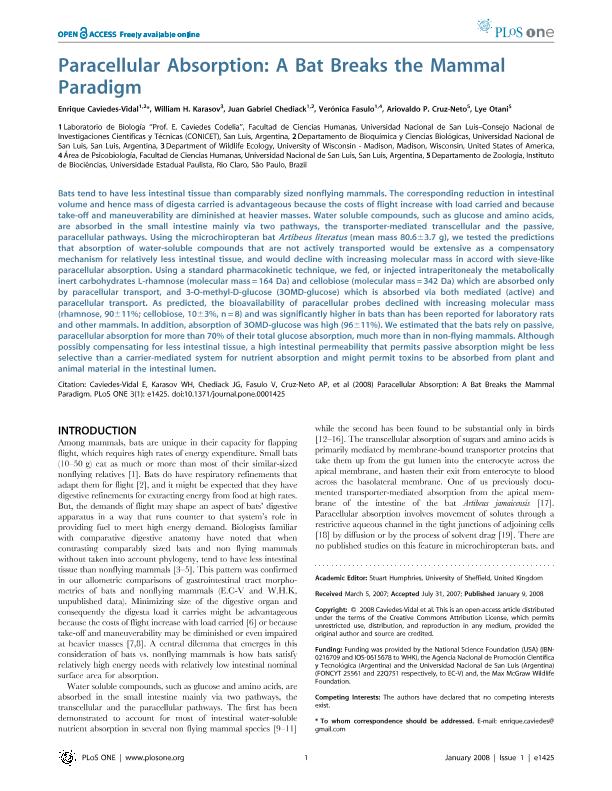Artículo
Paracellular absorption: A bat breaks the mammal paradigm
Caviedes Vidal, Enrique Juan Raul ; Karasov, William; Chediack, Juan Gabriel
; Karasov, William; Chediack, Juan Gabriel ; Fasulo, Sara Veronica; Cruz Neto, Ariovaldo P.; Otani, Lye
; Fasulo, Sara Veronica; Cruz Neto, Ariovaldo P.; Otani, Lye
 ; Karasov, William; Chediack, Juan Gabriel
; Karasov, William; Chediack, Juan Gabriel ; Fasulo, Sara Veronica; Cruz Neto, Ariovaldo P.; Otani, Lye
; Fasulo, Sara Veronica; Cruz Neto, Ariovaldo P.; Otani, Lye
Fecha de publicación:
01/2008
Editorial:
Public Library of Science
Revista:
Plos One
ISSN:
1932-6203
Idioma:
Inglés
Tipo de recurso:
Artículo publicado
Clasificación temática:
Resumen
Bats tend to have less intestinal tissue than comparably sized nonflying mammals. The corresponding reduction in intestinal volume and hence mass of digesta carried is advantageous because the costs of flight increase with load carried and because take-off and maneuverability are diminished at heavier masses. Water soluble compounds, such as glucose and amino acids, are absorbed in the small intestine mainly via two pathways, the transporter-mediated transcellular and the passive, paracellular pathways. Using the microchiropteran bat Artibeus literatus (mean mass 80.6±3.7 g), we tested the predictions that absorption of water-soluble compounds that are not actively transported would be extensive as a compensatory mechanism for relatively less intestinal tissue, and would decline with increasing molecular mass in accord with sieve-like paracellular absorption. Using a standard pharmacokinetic technique, we fed, or injected intraperitonealy the metabolically inert carbohydrates L-rhamnose (molecular mass = 164 Da) and cellobiose (molecular mass = 342 Da) which are absorbed only by paracellular transport, and 3-O-methyl-D-glucose (3OMD-glucose) which is absorbed via both mediated (active) and paracellular transport. As predicted, the bioavailability of paracellular probes declined with increasing molecular mass (rhamnose, 90±11%; cellobiose, 10±3%, n = 8) and was significantly higher in bats than has been reported for laboratory rats and other mammals. In addition, absorption of 3OMD-glucose was high (96±11%). We estimated that the bats rely on passive, paracellular absorption for more than 70% of their total glucose absorption, much more than in non-flying mammals. Although possibly compensating for less intestinal tissue, a high intestinal permeability that permits passive absorption might be less selective than a carrier-mediated system for nutrient absorption and might permit toxins to be absorbed from plant and animal material in the intestinal lumen.
Palabras clave:
fruit bats
,
paracellular absorption
,
digestive phisiology
,
mammals
Archivos asociados
Licencia
Identificadores
Colecciones
Articulos(IMIBIO-SL)
Articulos de INST. MULTIDICIPLINARIO DE INV. BIO. DE SAN LUIS
Articulos de INST. MULTIDICIPLINARIO DE INV. BIO. DE SAN LUIS
Citación
Caviedes Vidal, Enrique Juan Raul; Karasov, William; Chediack, Juan Gabriel; Fasulo, Sara Veronica; Cruz Neto, Ariovaldo P.; et al.; Paracellular absorption: A bat breaks the mammal paradigm; Public Library of Science; Plos One; 3; 1; 1-2008; 1-8
Compartir
Altmétricas



